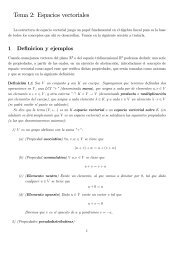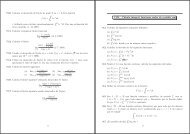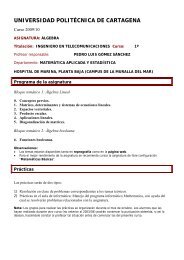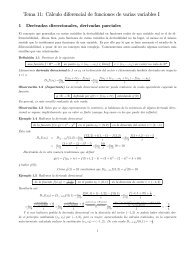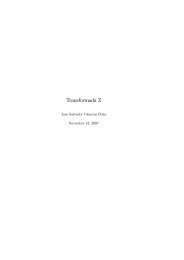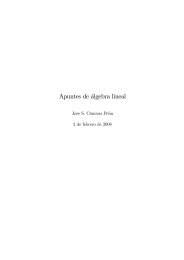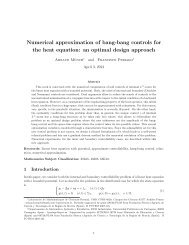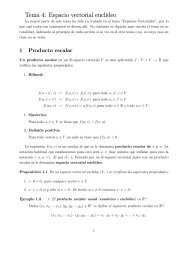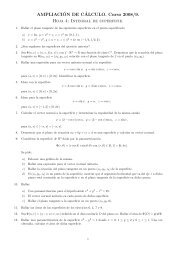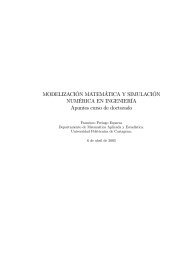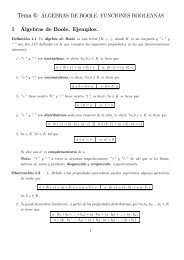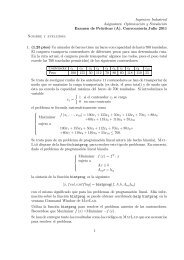Tema 9: Integral de Riemann
Tema 9: Integral de Riemann
Tema 9: Integral de Riemann
Create successful ePaper yourself
Turn your PDF publications into a flip-book with our unique Google optimized e-Paper software.
4.2 De revolución<br />
El volumen <strong>de</strong>l sólido obtenido al revolucionar (o girar) una curva continua y = f(x) alre<strong>de</strong>dor <strong>de</strong>l<br />
eje OX alolargo<strong>de</strong>lintervalo[a, b] se calcula mediante la integral<br />
Z b<br />
πf(x) 2 dx<br />
a<br />
Se <strong>de</strong>nomina sólido <strong>de</strong> revolución. Si el giro se hace alre<strong>de</strong>dor <strong>de</strong> un eje <strong>de</strong> ecuación y = c la fórmula<br />
es<br />
Z b<br />
π[f(x) − c] 2 dx<br />
a<br />
(Notemos que el giro a lo largo <strong>de</strong>l eje OX es un caso particular <strong>de</strong> lo anterior pues este eje tiene<br />
por ecuación y =0.)<br />
También es posible girar la curva alre<strong>de</strong>dor <strong>de</strong>l eje OY . Suponiendo que en el intervalo la curva<br />
es siempre creciente o siempre <strong>de</strong>creciente, la integral que nos da ese volumen es<br />
Z b<br />
a<br />
2πxf(x)dx<br />
Si el giro se realiza alre<strong>de</strong>dor <strong>de</strong> un eje <strong>de</strong> la forma x = c el volumen <strong>de</strong>l sólido <strong>de</strong> revolución obtenido<br />
es<br />
b−c Z<br />
a−c<br />
2πxf(x + c)dx<br />
Observación 4.2 Cualquiera <strong>de</strong> estas fórmulas se pue<strong>de</strong> obtener a partir <strong>de</strong>l apartado anterior,<br />
calculando el sólido a partir <strong>de</strong> sus secciones planas transversales. Veamos por ejemplo, la primera.<br />
Basta darse cuenta <strong>de</strong> que la sección transversal plana <strong>de</strong>l sólido girado correspondiente a la abcisa<br />
x es un círculo <strong>de</strong> radio f(x).<br />
Ejemplo 4.3 Hallemos el volumen <strong>de</strong> un cono <strong>de</strong> radio r y<strong>de</strong>alturah.<br />
Po<strong>de</strong>mos obtenerlo como revolución alre<strong>de</strong>dor <strong>de</strong>l eje OX <strong>de</strong> la recta que pasa por los puntos (0, 0)<br />
y (h, r), es <strong>de</strong>cir <strong>de</strong> la curva <strong>de</strong> ecuación y = r x en el intervalo [0,h]. Deestemodoeláreasería<br />
h<br />
Z h<br />
0<br />
π r2<br />
h 2 x2 dx = π r2<br />
h 2 [x3 3 ]h 0 = π r2 h 3<br />
h 2 3 = 1 3 πr2 h<br />
Ejemplo 4.4 Hallemos el volumen <strong>de</strong> un cilindro <strong>de</strong> radio r y<strong>de</strong>alturah.<br />
Po<strong>de</strong>mos obtenerlo como revolución alre<strong>de</strong>dor <strong>de</strong>l eje OX <strong>de</strong> la recta que pasa por los puntos (0,r)<br />
y (h, r), es <strong>de</strong>cir <strong>de</strong> la curva <strong>de</strong> ecuación y = r en el intervalo [0,h]. Deestemodoeláreasería<br />
Z h<br />
πr 2 dx = πr 2<br />
Zh<br />
1dx = πr 2 [x] h 0 = πr 2 [h − 0] = πr 2 h<br />
0<br />
0<br />
22



